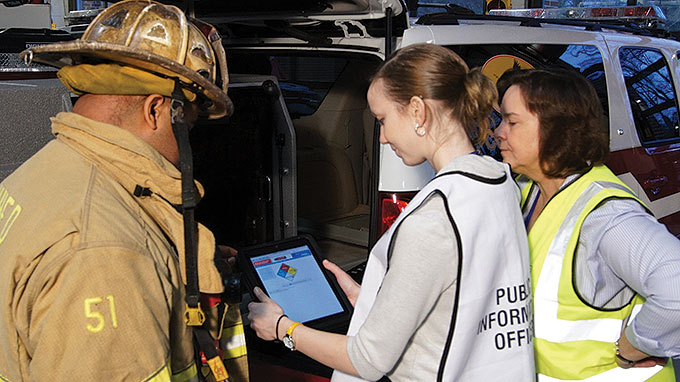This is the first of a series of articles about the many resources that the U.S. National Library of Medicine’s Disaster Information Management Research Center (DIMRC) makes available to the disaster community. This first article provides an overview of the Center.
 |
|
First responders and crisis managers use DIMRC information resources. |
T
he United States National Library of Medicine (NLM), the world’s largest biomedical library, has a long history of providing health information, training, and tools in response to all types of disasters and public health emergencies. NLM promotes information management and access to health information resources as key components of disaster medicine and public health. The establishment of the Disaster Information Management Research Center (DIMRC) in 2008 reflects NLM’s commitment to this national and international priority. The core purpose of DIMRC is to develop and provide access to health information resources and technology for disaster preparedness, response, and recovery. The Center’s intent is to connect people to quality disaster health information and foster a culture of community resiliency. DIMRC has made significant strides in the collection and dissemination of disaster health information, making it more readily available to first responders, crisis managers, health professionals, and the public.
DIMRC coordinates all of NLM disaster-related activities, including:
- The collection, organization, and dissemination of health information for all stages of preparedness, response, and recovery to natural, accidental, or deliberate disasters.
- Training and support for librarians to act as Disaster Information Specialists in meeting their communities’ needs. This includes developing core competencies, curriculum, and certification (administered by an association or university).
- Development, promotion, and training of disaster and emergency health resources (online and mobile) for health professionals and the public.
- Disaster-related informatics research and development projects both at NLM and through grants to other institutions.
- Development of innovative communications, training and other technologies and methodologies to support disaster preparedness and response.
- Collaboration with other government agencies involved in disaster health and medicine to ensure information needs receive adequate attention in planning for disasters and in providing education and training for responders.
- Planning and training for continuity of operations of libraries, including eight Regional Medical Libraries, and the 5,800 member-libraries of its National Network of Libraries of Medicine.
DIMRC also coordinates outreach and training on the use of NLM resources by disaster personnel and assists and collaborates with the international disaster information community. Other activities include:
- Publishing results from its own research and development activities.
- Promoting NLM partnerships with hospitals and libraries as collaboration models to enhance community disaster resilience.
- Promoting and supporting the development of an international network of disaster information centers in the Americas and the Caribbean (RELACIGER – www.relaciger.org)
NLM and PAHO have collaborated for many years in a variety of international projects, including the development of the RELACIGER network, enhancing the access to biomedical literature from the Pan American region, and more. For more information about DIMRC, please visit their website at http://disasterinfo.nlm.nih.gov or contact Stacey Arneson at This email address is being protected from spambots. You need JavaScript enabled to view it..
